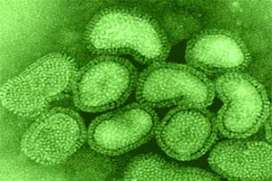WASHINGTON, January 17, 2016 – On Jan. 15 the United States Department of Agriculture’s (USDA) Animal and Plant Health Inspection Service (APHIS) confirmed the presence of highly pathogenic H7N8 avian influenza (HPAI) in a commercial turkey flock in Dubois County, Indiana.
Shortly thereafter, the Associated Press reported outbreaks had been found at nine more Indiana farms near the location where authorities first confirmed the H7N8 strain, which is different from the one that ravaged the U.S. poultry industry last summer.
Denise Derrer, spokeswoman for the Indiana State Board of Animal Health, said that farmers began euthanizing turkeys at the new farms even before final results of whether the birds were infected with the H7N8 strain. Final results are expected soon from a government laboratory in Ames, Iowa.
According to the AP, the nine farms are located in Dubois County, about 70 miles from Louisville, Kentucky. All of the new infections are within a quarantine area set up around the first farm and that area has been expanded to four neighboring Indiana counties: Martin, Orange, Crawford and Daviess.
Confirmation of new bird flu cases alarmed industry officials after the rapid spread of the H5N2 virus last year led to the deaths of about 48 million turkeys and chickens, and drove egg prices higher.
The USDA explains that this is a different strain of HPAI than the strains that caused the 2015 outbreak, and there are no known cases of H7N8 infections in humans. As a reminder, the proper handling and cooking of poultry and eggs to an internal temperature of 165 ˚F kills bacteria and viruses, including HPAI.
From the USDA:
Samples from the first Indiana turkey flock, which experienced increased mortality, were tested at the Indiana Animal Disease Diagnostic Laboratory at Purdue University, which is a part of USDA’s National Animal Health Laboratory Network, and confirmed by USDA this morning. APHIS is working closely with the Indiana State Board of Animal Health on a joint incident response. State officials quarantined the affected premises and depopulation of birds on the premises has already begun. Depopulation prevents the spread of the disease. Birds from the flock will not enter the food system.
As part of existing avian influenza response plans, federal and state partners are working jointly on additional surveillance and testing in the nearby area. The rapid testing and response in this incident is the result of months of planning with local, state, federal and industry partners to ensure the most efficient and effective coordination.
Since the previous HPAI detections in 2015, APHIS and its state and industry partners have learned valuable lessons to help implement stronger preparedness and response capabilities. In September, APHIS published a HPAI Fall Preparedness and Response Plan that captures the results of this planning effort, organizing information on preparatory activities, policy decisions and updated strategy documents.
The United States has the strongest AI surveillance program in the world, and USDA is working with its partners to actively look for the disease in commercial poultry operations, live bird markets and in migratory wild bird populations.
Anyone involved with poultry production, from the small backyard to the large commercial producer, should review their biosecurity activities to assure the health of their birds. To facilitate such a review, a biosecurity self-assessment and educational materials can be found at http://www.uspoultry.org/animal_husbandry/intro.cfm
In addition to practicing good biosecurity, all bird owners should prevent contact between their birds and wild birds and report sick birds or unusual bird deaths to State/Federal officials, either through their state veterinarian or through USDA’s toll-free number at (866) 536-7593. Additional information on biosecurity for backyard flocks can be found at http://healthybirds.aphis.usda.gov.


